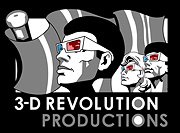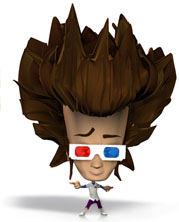Get your $2 worth of 3-D
With film producers and distributors boiling down the Stereoscopic film equation to the $2 mark-up for a 3-D film ticket, audiences are starting to air their demands for $2 worth of 3-D entertainment...
The following article I wrote can be found in the excellent 3-D publication Veritas et Visus (3rd Dimension edition). I can highly recommend this online magazine for anybody working in the Stereoscopic industry, so do check it out: http://www.veritasetvisus.com/3rd_dimension.htm
...As the average 2009 cinema ticket price in the US is $7.20, that amounts to a mark-up of 22%. So a bit less than a quarter or a bit more than a fifth of the film’s duration should be using engaging, entertaining 3-D to keep the patrons happy. If you charge $2 more for 90 minutes of cinematic entertainment, you are going to have to deliver the extra 20 minutes of 3-Dimensional cherry on top.
When it comes to 3-D, that cherry is more often than not the in-your-face stuff: good old negative parallax, theatre space, the out-of-screen area. One look at the trailer for ‘My Bloody Valentine 3-D’ (2009) and it becomes clear how people equate the term ‘3-D’ with pick-axes flying at the camera and flames engulfing the theatre (even when flames are, in fact, 2D forms). Funnily, the trailer goes straight against the director’s own promotional words of how the 3-D is not used in a cheap and cheesy way like previous 3-D movies! Pretty much all promotional artwork for 3-D feature films throughout cinema history have featured objects jumping out of a cinema screen. It is undeniable that the two or three 3-D shots people remember when they come out of the theatre are almost always negative parallax shots so their importance in the bigger picture of a successful 3-D film experience is immense. That is not to say that a 3-D feature film should consist of an endless bombardment of negative parallax action - ‘Treasure of the Four Crowns’ (1983) is a very good example of what that looks like: throwaway fairground fodder.
Film poster of 'Treasure of the Four Crowns' (1983)
So far, storyboarders, designers, directors and cameramen have mostly underestimated the importance and complexity of a good negative parallax shot and underinvested in developing new grammar for this part of the visual language of stereoscopic cinematography. It could be because out-of-screen shots pose an almost impossible challenge for narrative visual storytelling: how can these objects coming out of the screen be used to enhance the story, action and character interaction without engaging with the viewer in first person? So far, only very few 3-D films have managed to have a decent negative parallax shot or two that is not out of place or totally obtrusive. A shot that comes to mind is Jared-Syn’s deadly arm in 'Metalstorm' (1983). The negative parallax in this shot serves a narrative function, is spectacular in slow-motion 3-D and doesn’t take the audience out of the movie. Suspension of disbelief is sustained. But no, it wouldn’t work for longer than the duration of that particular shot and later shots in the movie show the usual stretched arms holding guns, coming out of the screen. Not very intelligent use of out-of-screen space. But then most scenes involving theatre space in 3-D film scripts appear to have been written on the backs of beer coasters, with very childish visuals result.
Still from 'Metalstorm' (1983)
How would it fly with the audience if an actor of a play started talking to them or even waving a stick at them? And what if the actor were to walk into the audience and talk to the other actors on stage from there? It could be called ‘modern’, perhaps ‘abstract’, but in any case quite odd and probably not helping the flow of the story. It is this dilemma that 3-D film is facing and has always faced: how to make that oddity work in a serious, undamaging way. This is especially relevant as the discussed 22% of the film needs to pay off in the way people remember and love 3-D. And so far nobody has ever said that the deep scenery of a 3-D film has stuck with them for a long time.
3-D eye poking is very much like camera access, camera shakes, on-screen text and other camera-affirming techniques in cinema. It must be approached with the rules to these techniques in mind. The reason for using camera access, interaction with a camera, bumping into the camera, splatter on the camera lens and even showing a camera crew can be for comedic effect, to indicate the camera as a person, to talk directly to the audience in a medieval theatre style or to touch upon a documentary situation for heightened reality and closeness to the action. But with it comes the breaking down of the fourth wall and the illusion – disbelieve is unsuspended.
'Ferris Bueller's Day off' (1986) - constant camera access
A major issue is that the dimensionality easily distracts the viewer from the story and its characters and negative parallax pushes the viewer’s suspension of disbelieve to the limit. More often than not, these shots remind the viewer he is watching a movie and take the viewer out of it completely. The ability to lose one self in the story and character interaction gets dealt a heavy blow by objects sticking out into theatre space. By observing and analysing the negative parallax object, the brain switches sides from creative (left) to analytical observing (right): the worst possible thing that can happen when being told a story. It is especially wry when all a cinema theatre is trying to do is remove cues to the fact one is sitting in a chair watching a movie to enhance the cinema-going experience to its fullest potential. Paradoxically, by getting close to the viewer’s face, the 3-D movie reminds the viewer he is not actually part of the on-screen events. That which makes stereoscopic film great – the ability to get a film closer to the audience – can take away from the very factors that make for cinematic enjoyment.
'Dial M for Murder' (1954) - negative parallax fame
Basically, theatre space can be used a lot without a problem by movies that don’t take themselves too seriously, that are more of a realistic/documentary-style breed, films that are confident enough to use first-person and POV shots or those that are more or less glorified thrill rides. For movies that don’t want to sacrifice their serious nature, subtle negative parallax shots such as the scissors-grabbing shot in ‘Dial M for Murder’ (1954) may just about work, but they can’t fill a fifth of the available screen time with characters reaching into the audience. A solution to the problem may come from a recognition by producers, distributors, theatres and the audience that 3-D movies are a different medium altogether – neither film nor theatre, but volumetric narrative visual entertainment of its own. A new medium with new rules – where the fourth wall can be broken at will and where serious drama is followed by visual puns and an opportunity to examine objects and scenery in volumetric detail. Because an evolution of film won’t happen until old conventions and ideas are abandoned and new ones are fully embraced.
Pie-throwing in 'The Three Stooges - Pardon my Backfire' (1953)![]()
![]()
![]()
![]()
![]()
![]()
![]()
![]()
![]()
![]()
![]()
![]()




